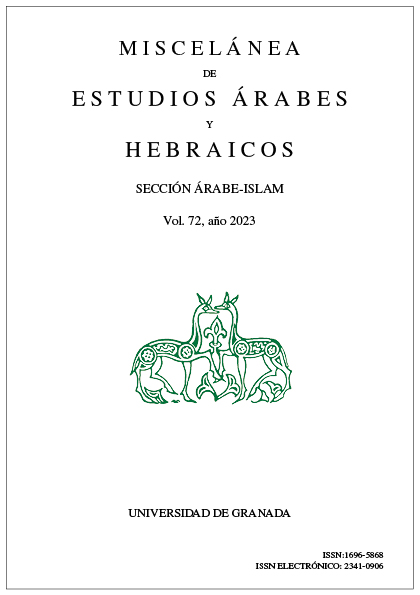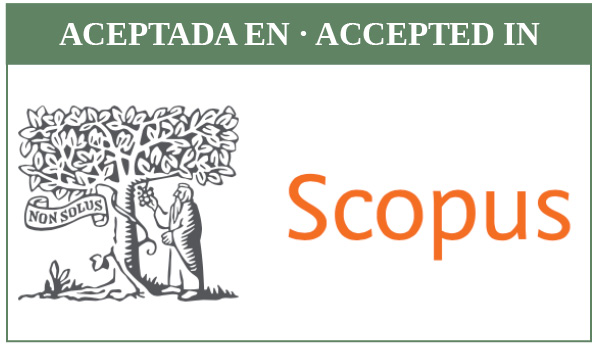Ibn Khaldūn in his Subjective Lexicon. The Emotional Constellation of an Intellectual in Transition
Ibn Jaldūn en su léxico subjetivo. La constelación emocional de un intelectual en transición
DOI:
https://doi.org/10.30827/meaharabe.v72.21618Palabras clave:
Ibn Jaldūn, Occidente islámico, Transición, Modernidad, SubjetividadResumen
El presente estudio se centra en el análisis lingüístico del léxico subjetivo utilizado por el pensador norteafricano ‘Abd al-Raḥmān Ibn Jaldūn (m. 1406) en el epílogo de su obra histórica Kitāb al-‘Ibar, conocida como Ta‘rīf, donde se biografía a sí mismo. El objetivo es esbozar la utilidad de construir un esquema analítico de los fenómenos lingüísticos en los que emerge la primera persona, especialmente en la autorreferencia, las acciones, las emociones y las evaluaciones, para captar la complejidad de la autoexpresión de Ibn Jaldūn. Una metodología híbrida cuantitativa y cualitativa ayuda a extraer, organizar, analizar e interpretar su uso del lenguaje para expresarse en relación con la narración de su trayectoria vital y su evolución psicológica. Los datos muestran una expresión íntima de un sujeto árabe premoderno, lo que lleva a considerar el Ta‘rīf como un eslabón evolutivo de la autobiografía moderna, que adquiere una gran importancia dentro del proceso de transición cultural del Occidente islámico hacia la modernidad europea.
Descargas
Citas
ABD AL-ḤAMĪD, Muḥammad Muḥyī l-Dīn. Durūs al-taṣrīf. Al-qism al-awwal: fī l-muqaddimāt wa-taṣrīf al-af‘āl. Beirut: al-Maktaba al-‘Aṣriyya, 1995.
‘ABD AL-JALĪL, Manqūr. ‘Ilm al-dalāla: uṣūluh wa-mabāḥithuh fī l-turāth al- ‘arabī. Damascus: Ittiḥād al-Kuttāb al-‘Arab, 2001.
AHMAD, Zaid. The Epistemology of Ibn Khaldūn. London and New York: RoutledgeCurzon, 2003.
ALATAS, Syed Farid. Ibn Khaldun. Oxford: Oxford University Press, 2013.
ALATAS, Syed Farid. Applying Ibn Khaldūn: the recovery of a lost tradition in sociology. Abingdon and New York: Routledge, 2014.
AZARI, Bahar et al. “Comparing supervised and unsupervised approaches to emotion categorization in the human brain, body, and subjective experience”. Scientific Reports, 10, 20284 (2020). https://doi.org/10.1038/s41598-020-77117-8
BAKER, Paul; HARDIE, Andrew and MCENERY, Tony. A glossary of corpus linguistics. Edinburgh: Edinburgh University Press, 2006.
BARKEY, Karen. Empire of difference: the Ottomans in comparative perspec- tive. Cambridge: Cambridge University Press, 2008.
BELINKOV, Yonatan; MAGIDOW, Alexander; ROMANOV, Maxim; SHMIDMAN, Avi and KOPPEL, Moshe. “Shamela: a large-scale historical arabic corpus”. In E. HINRICHS, M. HINRICHS and T. TRIPPEL (ed.). Pro- ceedings of the Workshop on Language Technology Resources and Tools for Digital Humanities (LT4DH). Osaka: The COLING 2016 Organizing Com- mittee, 2016, pp. 45-53.
—; —; BARRÓN-CEDEÑO, Alberto, SHMIDMAN, Avi and ROMANOV,
Maxim. “Studying the history of the Arabic language: language technology and a large-scale historical corpus”. Language Resources and Evaluation, 53 (2019), pp. 771-805.
BERNARDS, Monique. “Ḥāl”. In Kees VERSTEEGH et al. (ed.). Encyclopedia of Arabic Language and Linguistics: Volume II Eg-Lan. Leiden: Brill, 2007, pp. 224-228.
COOKE, Miriam. “Ibn Khaldun and language: from linguistic habit to philologi- cal craft”. Journal of Asian and African Studies, 18, 3-4 (1983), pp. 179-188.
DANKS, Warwick. The Arabic verb: form and meaning in the vowel-lengthening patterns. Amsterdam and Philadelphia: John Benjamins, 2011.
DAYEH, Islam and MESSLING, Markus. “Early modern ‘new sciences’: inqui- ries into Ibn Khaldun and Giambattista Vico”. Philological Encounters, 5, 1 (2020), pp. 1-3.
DITTERS, Everhard. “Maṣdar”. In Kees VERSTEEGH et al. (ed.). Encyclopedia of Arabic Language and Linguistics: Volume III Lat-Pu. Leiden: Brill, 2008, pp. 164-169.
ENGLEBRETSON, Robert. “Stancetaking in discourse: an introduction”. In R. ENGLEBRETSON (ed.). Stancetaking in discourse: subjectivity, evaluation, interaction. Amsterdam and Philadelphia: John Benjamins, 2007, pp. 1-25.
FAYYĀḌ, Sulaymān. Al-Ḥuqūl al-dalāliyya al-ṣarfiyya li-l-af‘āl al-‘arabiyya. Riyadh: Dār al-Marrīkh, 1990.
FISCHEL, Walter. Ibn Khaldūn and Tamerlane: their historic meeting in Da- mascus, 1401 A. D. (803 A. H.). Berkeley and Los Angeles: University of Ca- lifornia Press, 1952.
FOUCAULT, Michel. L’archéologie du savoir. Paris: Gallimard, 1969. FROMHERZ, Allen J. Ibn Khaldun, life and times. Edimburgo: Edinburgh Uni-
versity Press, 2010.
FUOLI, Matteo and HOMMERBERG, Charlotte. “Optimising transparency, re- liability and replicability: annotation principles and inter-coder agreement in the quantification of evaluative expressions”. Corpora, 10, 3 (2015), pp. 315-349.
GARCÍA GÓMEZ, Emilio. Foco de antigua luz sobre la Alhambra. Desde un texto de Ibn al-Jaṭīb en 1362. Madrid: Instituto Egipcio de Estudios Islámicos, 1988.
GODDARD, Cliff and WIERZBICKA, Anna. Words and meanings: lexical se- mantics across domains, languages, and cultures. Oxford: Oxford University Press, 2014.
GUIRAUD, Pierre. Structures étymologiques du lexique français. Paris: La- rousse, 1967.
HABASH, Nizar. Introduction to Arabic natural language processing. Morgan & Claypool, 2010.
HABIB, Sandy. “Heaven and hell are here! the non-religious meanings of English heaven and hell and their Arabic and Hebrew counterparts”. In B. PEETERS;
K. MULLAN and L. SADOW (ed.). Studies in ethnopragmatics, cultural se- mantics, and intercultural communication: meaning and culture. Singapore: Springer, 2020, pp. 149-165.
HUNSTON, Susan. “Using a corpus to investigate stance quantitatively and qua- litatively”. In R. ENGLEBRETSON (ed.). Stancetaking in discourse: subjec- tivity, evaluation, interaction. Amsterdam and Philadelphia: John Benjamins, 2007, pp. 27-48.
IBN KHALDŪN, ‘Abd al-Raḥmān. The Muqaddimah: An Introduction to Histo- ry. Trans. Franz Rosenthal. London: Routledge & Kegan Paul, 1958.
—. Riḥlat Ibn Khaldūn. Ed. Muḥammad b. Tāwīt al-Ṭanjī. Beirut: Dār al-Kutub al-‘Ilmiyya, 2004.
IBN KHALDŪN, ‘Abd al-Raḥmān. Autobiographie. Trad. ‘Abd al-Salām al- Shaddādī. Témara: Maison des Arts, des Sciences et des Lettres, 2006.
—. Kitāb al-‘Ibar wa-dīwān al-mubtada’ wa-l-khabar fī ayyām al-‘arab wa-l- ‘ajam wa-l-barbar wa-man ‘āṣarahum min dhawī l-sulṭān al-akbar. Al-Kitāb al-Awwal: al-Muqaddima. Ed. Ibrāhīm Shabbūḥ and Iḥsān ‘Abbās. Tunis: al- Qayrawān li-l-Nashr, 2007.
IBRAHIM, Wesam and HARDIE, Andrew. “Accessible corpus annotation for Arabic”. In T. MCENERY; A. HARDIE and N. YOUNIS (ed.). Arabic cor- pus linguistics. Edinburgh: Edinburgh University Press, 2019, pp. 56-75.
JARMOUNI, Mostapha. Ibn Jaldún: autobiografía y viajes a través de Occidente y Oriente. Granada: Editorial Universidad de Granada, 2019.
JONES, Linda. The power of oratory in the medieval Muslim world. Cambridge: Cambridge University Press, 2012.
JREIS NAVARRO, Laila M. “Contextos de autoexpresión. Voces andalusíes en el exilio de la convención”. Journal of Medieval Iberian Studies, 9, 1 (2017), pp. 130-147.
—. “Inhabiting the Strait. Towards a Euro-African subjectivity in premodern Arabic texts”. Intus-Legere Historia, 14, 1 (2020), pp. 217-239.
KUHN, Jonas. “Computational text analysis within the humanities: how to com- bine working practices from the contributing fields?”. Language Resources and Evaluation, 53 (2019), pp. 565-602.
LANE, Edward William. An Arabic-English lexicon: part III د –ز. Beirut: Librairie Du Liban, 1968.
LEEMANS, Inger. “Large data set mining”. In S. Broomhall (ed.). Early modern emotions: an introduction. London and New York: Routledge, 2017, pp. 27- 30.
LÉVI-PROVENÇAL, Evariste and GARCÍA GÓMEZ, Emilio. El siglo XI en 1ª persona. Las “Memorias” de ‘Abd Allāh, último rey Zirí de Granada, destro- nado por los Almorávides (1090). Madrid: Alianza Editorial, 2010.
LIU, Bing. Sentiment analysis: opinion mining, sentiments, and emotions. Cam- bridge: Cambridge University Press, 2015.
MANZ, Beatrice F. et al. “Tīmūrids”. In P. BEARMAN et al. (ed.). Encyclopae- dia of Islam, Second Edition. http://dx.doi.org/10.1163/1573- 3912_islam_COM_1224
MANZANO, Miguel Ángel. “Ibn Jaldūn, ʿAbd al-Raḥmān”. In J. LIROLA and J. M. PUERTA (eds.). Biblioteca de al-Andalus: De Ibn Dabbāg a Ibn Kurz. Almeria: Fundación Ibn Tufayl de Estudios Árabes, 2004, pp. 578-597.
MUSAWI, Muhsin J. Al-. The medieval Islamic Republic of letters. Notre Dame: University of Notre Dame Press, 2015.
NIGST, Lorenz; ROMANOV, Maxim; SAVANT, Sarah Bowen; SEYDI, Ma- soumeh, and VERKINDEREN, Peter. “OpenITI: a machine-readable corpus of Islamicate texts (version 2021.1.4)” [Data set] (2021). http://doi.org/10.5281/zenodo.4513723
PARTINGTON, Alan; DUGUID, Alison and TAYLOR, Charlotte. Patterns and meanings in discourse: theory and practice in corpus-assisted discourse stu- dies (CADS). Amsterdam and Philadelphia: John Benjamins, 2013.
PASHA, Arfath et al. “MADAMIRA: a fast, comprehensive tool for morphologi- cal analysis and disambiguation of Arabic”. In Proceedings of the Ninth In- ternational Conference on Language Resources and Evaluation (LREC’14). Reykjavik: European Language Resources Association (ELRA), 2014, pp. 1094-1101.
PLAMPER, Jan. The history of emotions: an introduction. Oxford: Oxford Uni- versity Press, 2015.
RAFFAELLI, Ida and KEROVAC, Barbara. “Morphosemantic fields in the ana- lysis of Croatian vocabulary”. Jezikoslovlje, 9, 1-2 (2008), pp. 141-169.
REYNOLDS, Dwight (ed.). Interpreting the self. Autobiography in the Arabic literary tradition. Berkeley: University of California Press, 2001.
RICŒUR, Paul. Soi-même comme un autre. Paris: Seuil, 1990.
ROMAN, André. “L’expression du «je» dans la langue arabe révélée”. Bulletin d’Études Orientales, 27 (1974), pp. 7-18.
ROSENWEIN, Barbara. Emotional communities in the early Middle Ages. New York: Cornell University Press, 2006.
—. Generations of feeling. A history of emotions, 600-1700. Cambridge: Cam- bridge University Press, 2016.
RYDING, Karin. A reference grammar of modern standard Arabic. New York: Cambridge University Press, 2005.
SHAKIR, Khalid. “Authorship verification in Arabic using function words: a controversial case study of Imam Ali’s book Peak of Eloquence”. Internatio- nal Journal of Humanities and Arts Computing, 13, 1-2 (2019), pp. 223-248.
SPIEGEL, Gabrielle. The past as text: the theory and practice of medieval histo- riography. Baltimore: The Johns Hopkins University Press, 1997.
TRITAR, Jalila. “Ibn Ḫaldūn dans le Taʿrīf et le voyage en Occident et en Orient: Un nom propre ou un nom d’auteur?”. Arabica, 56, 1 (2009), pp. 95-106.
VIGUERA MOLINS, María Jesús (ed.). Ibn Jaldún. El Mediterráneo en el siglo
XIV. Auge y declive de los Imperios. Exposición en el Real Alcázar de Sevilla. Mayo-Septiembre 2006. Granada y Sevilla: Fundación El Legado Andalusí y Fundación José Manuel Lara, 2006.
WIEBE, Janyce; BRUCE, Rebecca; MARTIN, Melanie; WILSON, Theresa and BELL, Matthew. “Learning subjective language”. Computational Linguistics, 30, 3 (2004), pp. 277-308.
—; WILSON, Theresa and CARDIE, Claire. “Annotating expressions of opi- nions and emotions in language”. Language Resources and Evaluation, 39 (2005), pp. 165-210.
WIERZBICKA, Anna. “Language and metalanguage: key issues in emotion re- search”. Emotion Review, 1, 1 (2009), pp. 3-14.
Descargas
Publicado
Cómo citar
Número
Sección
Licencia
Los autores que publican en esta revista están de acuerdo con los siguientes términos:
1. Los autores conservan los derechos de autor y garantizan a la revista el derecho de ser la primera publicación del trabajo al igual que licenciado bajo una Creative Commons Attribution License que permite a otros compartir el trabajo con un reconocimiento de la autoría del trabajo y la publicación inicial en esta revista.
2. Los autores pueden establecer por separado acuerdos adicionales para la distribución no exclusiva de la versión de la obra publicada en la revista (por ejemplo, situarlo en un repositorio institucional o publicarlo en un libro), con un reconocimiento de su publicación inicial en esta revista.
3. Se permite y se anima a los autores a difundir electrónicamente (por ejemplo, en repositorios institucionales o en su propio sitio web) la versión publicada de sus trabajos (versión post-print del editor) o, en su defecto, el de la versión post-print del autor ya evaluada y aceptada. Esto puede dar lugar a intercambios productivos, así como a una citación más temprana y mayor de los trabajos publicados (Véase The Effect of Open Access).
4. La revista no se hace responsable de las opiniones vertidas por los autores.















